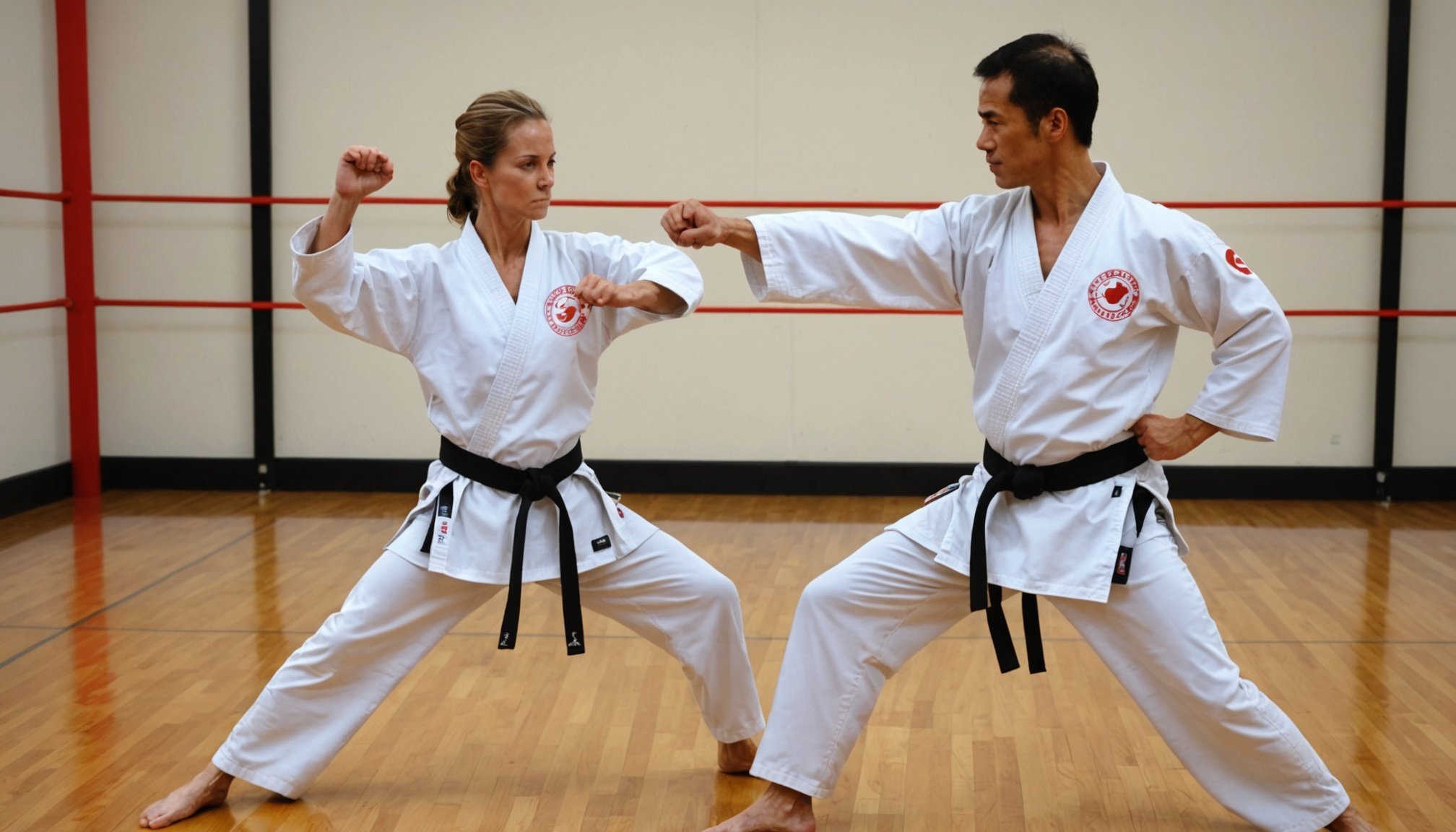Importance of Dynamic Stretching in Karate
Dynamic stretching is a vital component of karate training, significantly impacting karate performance and flexibility enhancement. By preparing the muscles through repeated motion, it primes practitioners for the demands of martial arts. Unlike static stretching, dynamic routines maintain momentum, activating the muscle groups required for effective karate practice.
The benefits of flexibility for karate practitioners cannot be understated. Enhanced flexibility not only enables a wider range of motion, crucial for executing precise strikes and blocks, but also reduces the risk of injuries. A flexible practitioner can react and counter more efficiently, demonstrating superior control and agility.
Topic to read : Unlock Peak Performance: Boosting Joint Flexibility for UK Combat Sports Athletes
By incorporating dynamic stretching, karatekas can experience enhanced performance and injury prevention. Regular practice of dynamic routines keeps the muscles warm and ready for intensive physical activity, lowering the chances of strains or sprains. Movements such as leg swings and arm circles elevate the practitioner’s heart rate while improving overall muscular coordination.
Overall, dynamic stretching is not just a preparatory activity; it’s an integral part of training that ensures a holistic improvement in flexibility and performance. Embracing these exercises allows karate practitioners to execute techniques with power and precision while maintaining their body’s resilience.
Additional reading : Empowering uk judo athletes: proven tactical approaches for match preparation success
Essential Dynamic Stretching Routines
Dynamic stretching routines are crucial in preparing the body for karate training. These routines help enhance flexibility by involving continuous movement, which is essential for agility and performance.
Upper Body Dynamic Stretches
Dynamic stretching for the upper body is vital for karate practitioners to ensure improved muscle preparedness and flexibility. Arm circles and shoulder openers are effective exercises to enhance mobility in the shoulders and arms. The incorporation of torso twists can significantly broaden one’s range of motion, crucial for executing effective punches and blocks. Adding a partner into the routine introduces dynamic chest stretches, promoting muscle engagement and flexibility.
Lower Body Dynamic Stretches
Dynamic flexibility exercises targeting the lower body are equally important. Leg swings are beneficial for enhancing hip mobility, a vital aspect for kicking techniques. Walking lunges with a twist can condition the lower limbs for improved performance and prevent injuries. Including high knees and butt kicks can activate lower limb muscles, ensuring readiness for the demands of karate.
Full Body Dynamic Stretches
Dynamic stretches such as inchworms serve as comprehensive routines to boost overall flexibility, engaging multiple muscle groups. Variations of dynamic squats are optimal warm-ups that prepare the body holistically, while jumping jacks offer a cardiovascular boost.
Modifications for Different Skill Levels
Dynamic stretching is vital for karate training, but modifications ensure safety and effectiveness across varying skill levels. For beginners, these adjustments prevent injury while fostering familiarity. Start with simpler movements, like light leg swings and basic arm circles, gradually building intensity as flexibility increases.
Beginner karate enthusiasts should maintain focus on control and balance, prioritising form over speed. Introduce stretch modifications such as reduced range movements, avoiding overstretching, which is crucial at initial stages. Emphasis should be on smooth, controlled motions, allowing the body to adapt gradually.
For advanced practitioners, dynamic stretching intensifies alongside skill enhancement. Incorporating complex routines like ballistic leg swings and multi-directional lunges can significantly boost karate performance. Advanced stretches demand robust core stability and greater flexibility enhancement, which in turn refine technique execution.
Customisation is integral, enabling karatekas to tailor dynamics to individual needs. Observing one’s flexibility and progress allows for a physically demanding yet safe practice. Additionally, understanding personal limitations and collaborating with instructors can lead to optimal exercise plans. With these stretch modifications, karatekas at all levels can maximise benefits and propel their training forward effectively.
Regional Training Considerations for UK Practitioners
For UK karate training, regional factors such as climate and available facilities play a pivotal role in shaping practice routines. Colder climates require more substantial dynamic stretching to adequately prepare the body. This prevents muscles from being stiff, reducing potential injuries.
Local adaptations are necessary for karate practitioners operating in the UK. Indoor spaces can be limited; therefore, creating home-based setups or utilising community halls may be beneficial. When considering outdoor training, it’s important to accommodate weather changes by selecting appropriate attire and ensuring a proper warm-up to counter the cool and damp conditions.
Using local resources, such as karate clubs or community centres, can offer additional support. They often provide insights into effective routines adapted to both climate and available space. These establishments are critical for fostering a community spirit and offering structured environments for training.
Moreover, practitioners can benefit from the collaborative nature of local clubs, where shared strategies for managing the UK’s unique training challenges are discussed. Leveraging these community resources not only cultivates skill enhancement but also strengthens resilience, enabling practitioners to persist in their karate journey regardless of environmental constraints.
Demonstrations and Video Resources
For those seeking to refine their karate training, leveraging stretching videos and dynamic exercise demonstrations can be invaluable. These visual aids clarify essential techniques, ensuring practitioners perform each stretch with accuracy. Videos serve as an insightful reference, breaking down complex movements into manageable steps.
Recommended Video Tutorials
- Video tutorials provide a systematic guide for each dynamic routine. By following structured sequences, karate enthusiasts can better integrate new stretches into their regimen. Tutorials often focus on key movements like arm circles and leg swings, explaining their benefits for performance and injury prevention.
Insights from Experienced Practitioners
Experienced practitioners often share valuable tips on maintaining proper form. Their insights highlight common pitfalls, such as overextending or rushing through exercises. Recognising these errors helps karatekas maximise the effectiveness of their flexibility exercises, translating to improved karate performance.
Compilation of Resources
A well-curated compilation of training resources can support ongoing development. Resources typically include a variety of video demonstrations focusing on different aspects of martial arts stretching. This diversity caters to individual needs, whether one seeks to enhance lower body flexibility or improve overall coordination.

